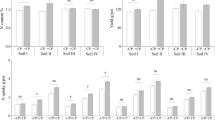Abstract
Rice, IR-28, was fertilized by urea at 48, 96, 144 or 192 kg N/ha under three application schedules: (1) complete basal application before submergence, (2) split application, basal and 30 days after transplanting, or (3) 15 and 45 days after transplanting. Plant growth, yield, N accumulation, and chemical fertilizer N-use efficiency were minimum under complete basal application. N fertilization at 15 and 45 days after transplanting was superior and formed the fastest and greatest colonization by cyanobacteria. The population profile comprised 64%Nostoc, 24%Anabaena and 8%Calothrix.Aulosira, Nodularia andTolypothrix were each less than 1% of the total heterocystous cyano-bacteria.
Similar content being viewed by others
References
Black, A., Evans, D.D., Ensminger, F.E., White, J.I., Clark, F.E. &Dinaver, R.G. 1965Methods of Soil Analysis—II. Chemical and Microbiological Properties. Series of Agronomy, No. 9. Madison, WI: American Society of Agronomy.
Broadbent, F.E., De Datta, S.K. &Laureles, E.V. 1987 Measurement of nitrogen fertilization efficiency in rice genotypes.Agronomy Journal 79, 786–791.
Dar, Gh.H., Zargar, M.Y., Mir, N.M. &Khan, M.A. 1990 Effect of blue-green algae (BGA) on rice yield in Kashmir.International Rice Research Newsletter 15, 25.
Fogg, G.E., Stewart, W.D.P., Fay, P. &Walsby, A.E. (eds) 1973The Blue-Green Algae. London and New York: Academic Press.
Jacq, V. &Roger, P.A. 1977 Diminution des fontes de semis dues à la sulfatoréduction, par un prétraitement des grains de riz avec des cyanophycées.Cahiers ORSTOM Serie Biologie 12, 101–107.
Mitsui, S. 1954Inorganic Nutrition, Fertilization, and Soil Amelioration for Lowland Rice. Tokyo: Yokendo.
Patrick, W.H. &Mahapatra, I.C. 1968 Transformation and availability to rice of nitrogen and phosphorus in waterlogged soils.Advances in Agronomy 20, 323–359.
Roger, P.A. 1982 Blue-green algae in rice fields—their ecology and their use as inoculant. Consultants' meeting FOA/IAEA Joint Project, Vienna, 11–15 October, 1982.
Roger, P.A. 1988 Reconsidering the utilization of blue-green algae in wetland rice cultivation. Presented at the International Symposium ‘Biological N2-fixation associated with rice production and rice culture’, December 1988, Cuttak, India.
Roger, P.A. &Kulasooriya, S.A. 1980 Blue-green Algae and Rice. Manila: International Rice Research Institute.
Roger, P.A., Santiago-Ardales, S., Reddy, P.M. &Watanabe, I. 1987 The abundance of heterocystous blue-green algae in rice soils and inocula used for application in rice fields.Biology and Fertility of Soils 5, 98–105.
Roychoudhury, P., Krishnamurti, G.S.R. &Venkataraman, G.S. 1980 Effect of algal inoculation on soil aggregation in rice soils.Phytos 19, 224–227.
Subrahamanyan, R., Relwani, L.L. &Manna, G.B. 1965 Fertility build-up of rice field soils by blue-green algae.Proceedings of the Indian Academy of Sciences, Series B 62, 252–277.
Venkataraman, G.S. 1966 Algalization.Phytos 5, 164–174.
Venkataraman, G.S. 1972Algal Biofertilizers and Rice Cultivation. Faridabad, Haryana, India: Today and Tomorrow's Printers.
Venkataraman, G.S. 1977 Blue-green algae as a biological input in rice cultivation. InProceedings of the National Symposium on Nitrogen Assimilation and Crop Productivity, Hissar, India, pp. 132–142.
Venkataraman, G.S. 1981Blue green Algae for Rice Production. A Manual for its Promotion. (FAO) Soil Bulletin No. 46. Rome: FAO.
Watanabe, L, De Datta, S.K. &Roger, P.A. 1987 Nitrogen cycling in wetland rice soils. InProceedings of the Symposium on Advances in Nitrogen Cycling in Agricultural Ecosystems, Brisbane, Australia, 11–15 May 1987, pp. 239–256.
Yanni, Y.G., Shaalan, S.N. &Mahrous, F.N. 1988a Evaluation of two methods of algalization by soil-based inoculum of blue-green algae according to their effects on growth and yield attributes of transplanted rice. InProceedings of the Second Conference of the Agricultural Development Research, Ain-Shams University, Cairo, Egypt, Vol. 2, pp. 191–203.
Yanni, Y.G., Shaalan, S.N. &Mahrous, F.N. 1988b Effect of algalization on rice plant growth, yield, N-content and efficiency of N-use under different nitrogen fertilization treatments. InProceedings of the Second Conference of the Agricultural Development Research, Ain-Shams University, Cairo, Egypt, Vol. 2, pp. 204–215.
Yanni, Y.G., Salem, K.GH. &Shaalan, S.N. 1988c Response of transplanted rice to algalization under different treatments of herbicides. InProceedings of the Second Conference of the Agricultural Development Research, Ain-Shams University, Cairo, Egypt, Vol. 2, pp. 216–226.
Author information
Authors and Affiliations
Rights and permissions
About this article
Cite this article
Yanni, Y.G. Potential of indigenous cyanobacteria to contribute to rice performance under different schedules of nitrogen application. World J Microbiol Biotechnol 7, 48–52 (1991). https://doi.org/10.1007/BF02310919
Revised:
Accepted:
Issue Date:
DOI: https://doi.org/10.1007/BF02310919




